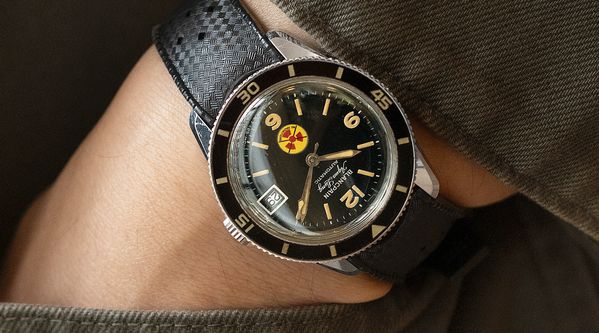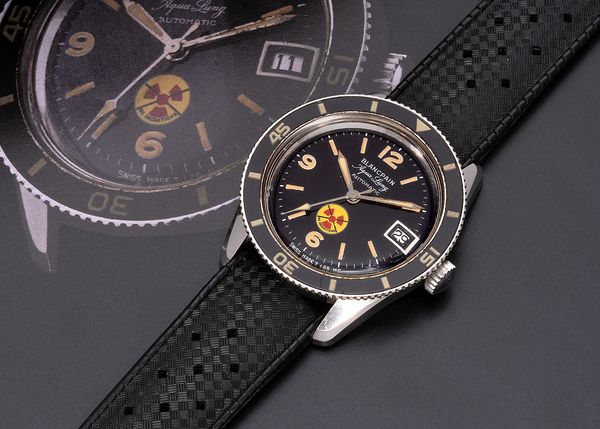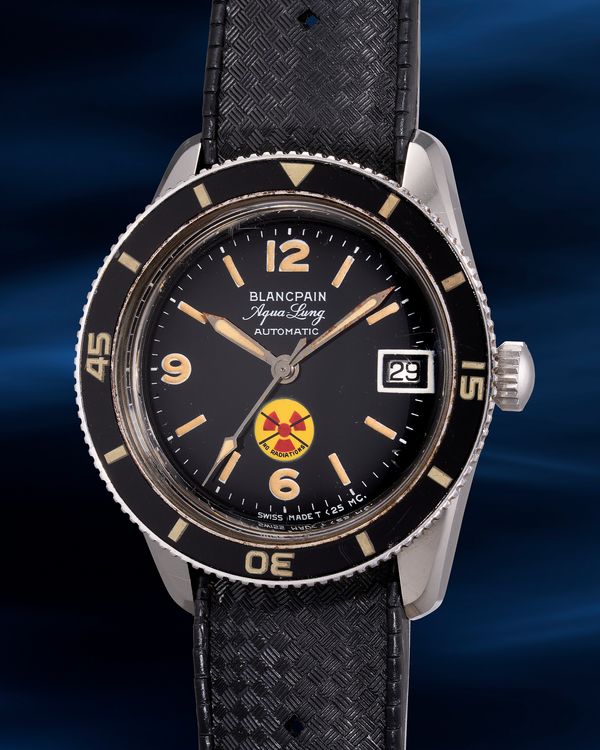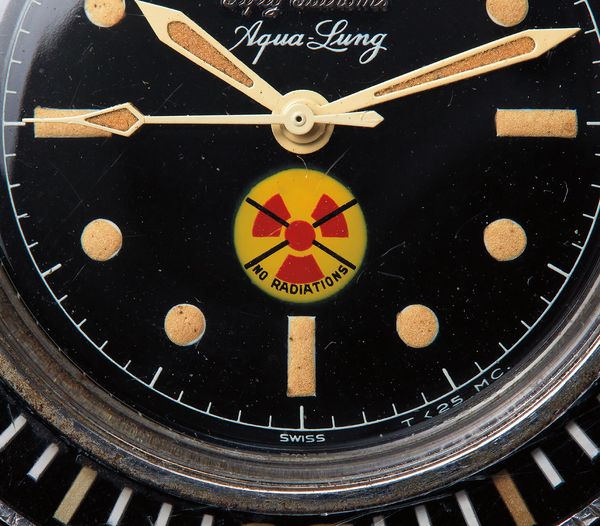Phillips in Association with Bacs & Russo is excited to announce The Hong Kong Sessions, Fall 2024, online auction, taking place from 12:00 PM HKT, Friday, September 20, to 2:00 PM HKT, Friday, September 27. Featuring more than 135 different high-end luxury wristwatches, the sale covers everything from A. Lange & Söhne and F.P. Journe to Audemars Piguet and Patek Philippe. It even includes the Blancpain Aqua Lung “No Rad” featured in this article.
Blancpain's name is synonymous with the introduction and evolution of the professional dive watch, and the Aqua Lung "No Rad" stands as a crucial chapter in this ongoing legacy.
Launched in the early 1960s, the Aqua Lung “No Radiations” Bathyscaphe offers not just a snapshot of the technological advances in dive watchmaking, but also reflects the growing environmental and health concerns of the Cold War era.
The Genesis: Blancpain Fifty Fathoms
Released in 1953, the Fifty Fathoms is considered by many to be the first professional dive watch, setting a standard that all subsequent dive watches would follow.
Designed by Blancpain’s CEO Jean-Jacques Fiechter – an avid diver himself – and developed in collaboration with the French Navy’s elite combat swimmer unit, the Fifty Fathoms was purpose-built to meet the demanding needs of military divers. It featured a water-resistant case, a unidirectional bezel for tracking dive times, and radium-lumed hands and markers for underwater legibility.
The Fifty Fathoms was not just a tool watch; it became a vital piece of equipment for military and professional divers alike.
However, by the early 1960s, the world was becoming increasingly aware of the dangers posed by radium – a radioactive material that had been commonly used in watch lume since the early 20th century. This concern coincided with the heightened anxieties of the Cold War, leading to the eventual shift in the materials used for luminescence in dive watches.
The Rise of the “No Rad” Era
By the early 1960s, Blancpain transitioned from using radium to the less dangerous tritium, which emits far lower levels of radiation. To reassure both professional and civilian divers that their watches were now safe, Blancpain added the “No Radiations” symbol to the dials of certain Fifty Fathoms models.
This bright yellow and red emblem featured a radiation symbol crossed out, signaling that the lume used on the watch no longer posed a health risk. Thus, the "No Rad" models were born.
The Aqua Lung “No Rad” is a particularly significant symbol of this era, not just for its technical specifications but also for its rarity and historical context.
Named after Jacques Cousteau's groundbreaking invention of the Aqua-Lung, this watch was primarily sold through specialist dive shops rather than luxury boutiques. This association with professional diving gear gives it an authenticity and functional heritage that few other watches can claim.
The Bathyscaphe: A Civilian Evolution
The Blancpain Aqua Lung “No Rad” diver was part of the Bathyscaphe collection – a more civilian-friendly interpretation of the Fifty Fathoms. Introduced in 1956, the Bathyscaphe was a smaller, 37mm model, designed for daily wear without compromising the core DNA of the original Fifty Fathoms. This model retained the essential features of a professional dive watch, including a glossy black dial, large luminous hands and indices, and a rotating bezel, now made from Bakelite – a durable, early form of plastic. Despite being more modest in size, the Bathyscaphe maintained Blancpain’s reputation for crafting robust and highly functional dive watches.
The Aqua Lung variant is immediately recognizable for the absence of the Fifty Fathoms branding, replaced with a bold “Aqua Lung” script. This distinction further solidified its association with the professional diving world and the Aqua-Lung diving apparatus, which had revolutionized underwater exploration by providing divers with a portable air supply.
A Closer Look at the “No Rad” Design
What sets the Blancpain Aqua Lung "No Rad" apart is not just its technical features, but also its stunning visual design, which has only grown more attractive with time. The dial boasts a deep black gloss finish that contrasts beautifully with the now-patinaed tritium lume, which has aged to a creamy, buttery color. The original luminous elements have remained remarkably well-preserved, still reacting under UV light, a testament to Blancpain’s exceptional build quality.
The “No Radiations” symbol at six o'clock immediately catches the eye, adding both a splash of color and historical significance to the otherwise understated dial. This symbol became an emblem of safety during a time when the dangers of radioactive materials were increasingly understood.
For collectors, the "No Rad" symbol has become a badge of distinction, representing a key period in both horological and scientific history.
The 37mm case is a hallmark of the Bathyscaphe design, with its compact size making it more versatile for daily wear. Yet, despite its smaller dimensions, the Aqua Lung "No Rad" remains a fully capable dive watch. The stepped case and lugs, paired with the glossy dial and the robust Bakelite bezel, give the watch a distinctive presence that feels both vintage and modern.
Why the Aqua Lung “No Rad” Matters Today
In recent years, the resurgence of interest in vintage dive watches has brought new attention to models like the Blancpain Aqua Lung “No Rad.”
For collectors, this watch represents a perfect blend of Blancpain's technical innovation, aesthetic refinement, and historical significance. While other dive watches from the 1960s have become icons – such as the Rolex Submariner or Omega Seamaster – the Aqua Lung "No Rad" remains a rare gem, highly prized for its unique design elements and its connection to the early days of modern diving.
This watch’s condition plays a crucial role in its collectability. In well-preserved examples, like the one featured here, the original tritium lume, glossy dial, and strong case condition elevate its status from a functional tool to a work of craftsmanship. Accompanied by a Heritage Authentication from Blancpain's heritage department, the Aqua Lung “No Rad” is confirmed to be original and authentic.
A Piece of Dive Watch History
From its roots in the original Fifty Fathoms to its role in signaling the shift away from radium-based lume, this watch encapsulates the evolution of dive watchmaking during one of the most important periods in modern horology.
For collectors and enthusiasts, the "No Rad" is not only a beautiful timepiece but also a symbol of a bygone era when watches were truly designed as tools for survival.
You can view the complete catalog for the Phillips Watches Hong Kong Sessions, Fall 2024, Online Auction, right here.
About Phillips In Association With Bacs & Russo
The team of specialists at PHILLIPS Watches is dedicated to an uncompromised approach to quality, transparency, and client service. Phillips in Association with Bacs & Russo holds the world record for the most successful watch auction, with its Geneva Watch Auction: XIV having realized $74.5 million in 2021. Over the course of 2021 and 2022, the company sold 100% of the watches offered, a first in the industry, resulting in the highest annual total in history across all the auction houses at $227 million.
Recommended Reading
Celebrating 15 Years Of The A. Lange & Söhne Zeitwerk
The Enduring Appeal Of Wolf’s Teeth Gearing In Fine Watchmaking





